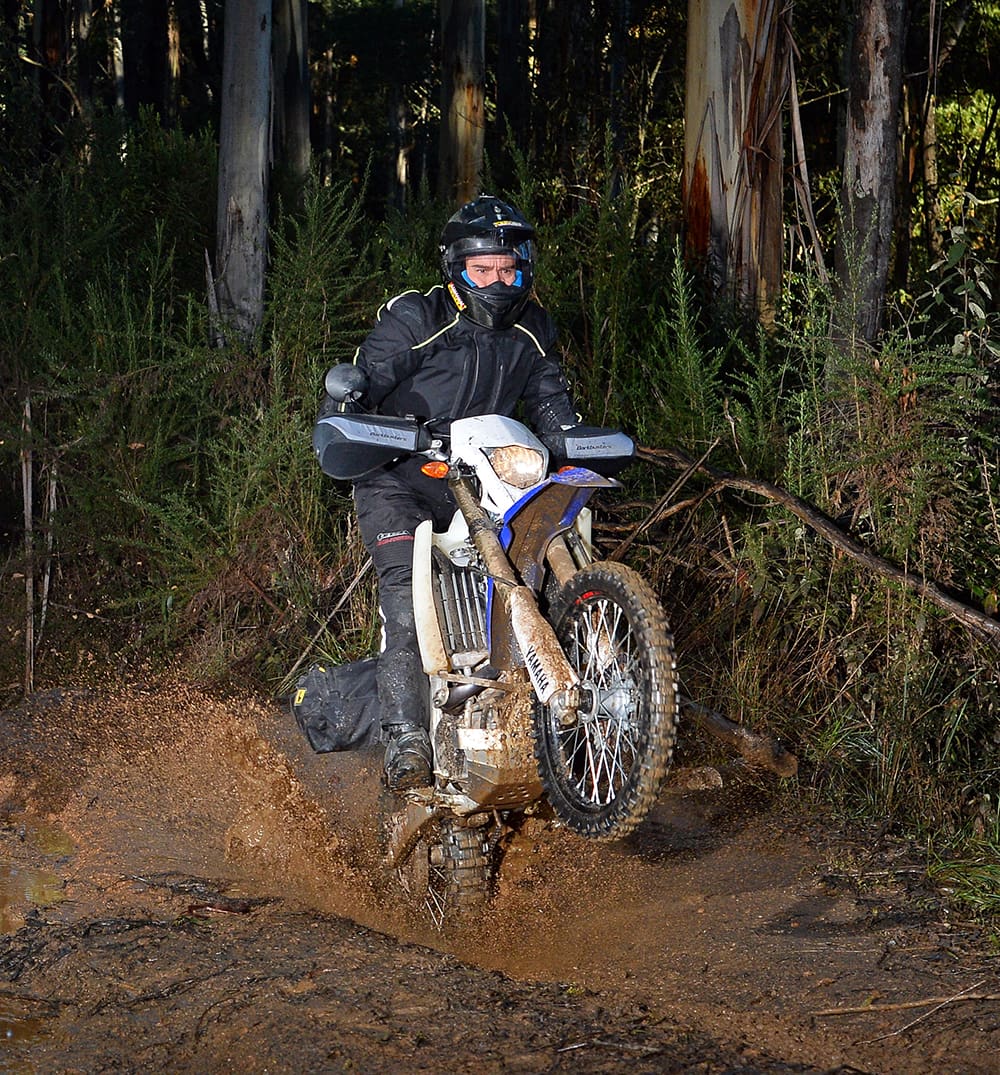We took a vast array of different adventure bikes into Victoria’s high country to sample the spectrum, and be bitten by the spirit
TEST Paul Young PHOTOGRAPHY Jeff Crow
Adventure riding has been around since motorcycles were invented, and the original pioneers endured challenges far beyond anything we can imagine. Now, thanks to modern motorcycles that make those early feats seem easy, the world has opened up to the romance of cross-continental travel.
The spectrum of what adventure riding means may have broadened to include everything from soft-road touring to journeys only achievable by the strong and the brave, but the spirit of adventure remains the same, and is there for all riders to embrace at their own level.
This feature is simply intended to describe the wide scope of adventure riding, to show that there are choices for all tastes, and hopefully inspire as many motorcyclists as possible to experience what escaping the rat race on your bike can do for your spirits.
Some may disagree with our description of the spectrum’s sectors, and with the bikes we have used to illustrate them, but that’s just the point: what works for me may not work for you. Bike choice will always depend on the rider’s ability and ambition. But now more than ever, there is a bike and an adventure out there for everyone. Just make your choice and go.
Soft Road
One for the road
Soft road is the easiest Adventure sector to define, and includes all the bikes which have adapted the Dakar look and dirtbike riding position into a package which is intended mostly for road use. Although these bikes are not created for going far off-road, their wide bars, upright riding position, and neutral weight distribution make them fairly adept at tackling well-maintained gravel roads.
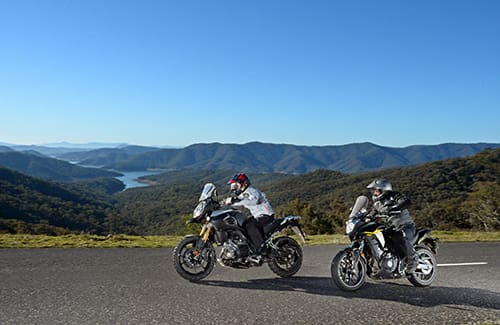
The major limiting factors to their capabilities are in their suspension and tyres. Both these areas can be upgraded fairly easily to extend the scope of any potential Adventure. Fitting a set of dual-sport tyres is the simplest way of improving dirt handling (check the tyre guide on page 102). Suspension can also be modified to give greater control on rough roads, and higher luggage capacity. Often, however, it is the length of wheel travel which is the limiting factor with these bikes. They can be toughened up for off-road use, but at some stage the cost will outweigh the benefits and it will make more sense to trade up to a bike with genuine off-road intentions.
2015 Suzuki v-strom 1000
This is an incredibly easy bike to get on with, and has a hell of a lot going for it as a commuter and touring bike which isn’t scared to eat a bit of dust every now and then.
Its neutral handling, soft linear power delivery and 19-inch front wheel make it a predictable soft-roader to venture onto gravel roads. Where it does fall short of being a full-blooded off-road Adventurer is in its suspension, as it blows through all of its limited travel easily when faced with boulders and pot holes. But on well-groomed gravel highways the big Strom is a real scream, in a good way.
Even though the ABS isn’t switchable, the intervention didn’t prove to be overly intrusive for off-road riding, but it is a factor which plants this bike firmly in the soft-road category. Traction control, on the other hand, can be disengaged for experienced dirt riders, and the V-Strom also has a mode with low sensitivity, which is ideal for less confident riders hitting the gravel for the first time.
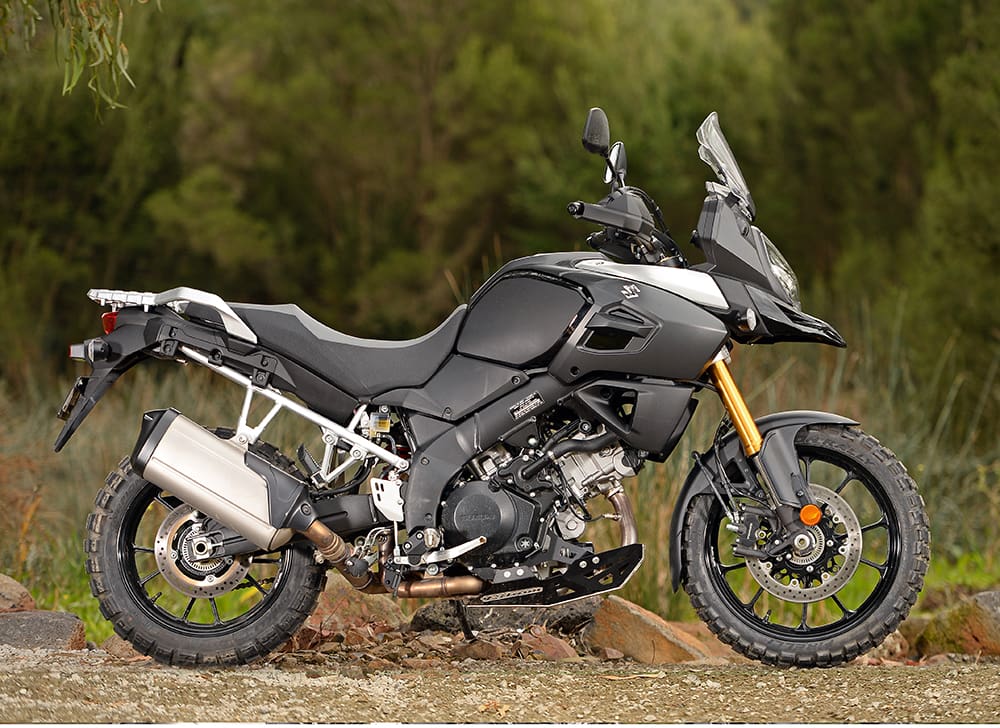
Part of the reason the bike feels so damn good on the road and on smooth gravel is its low centre of gravity. But two aspects of this characteristic also influence its rough road suitability. The low-slung engine requires the accessory aluminium sump guard to keep it safe from damage. And the low handlebars made it the least suitable bike on test for stand-up riding. Even at my paltry 173cm tall, I couldn’t stand up straight and reach the bars.
I’m a big fan of this bike on all but the rough stuff, and would love to see a dual-sport focused version. There’s always the DIY route, but the main issue will be extending suspension travel, and for epically ambitious adventures the standard 20-litre tank may also leave you short.
But if you are looking for an affordable, comfortable and accomplished big-bore roadbike which also inspires confidence when things get a little loose, the V-Strom 1000 is well worth a look.
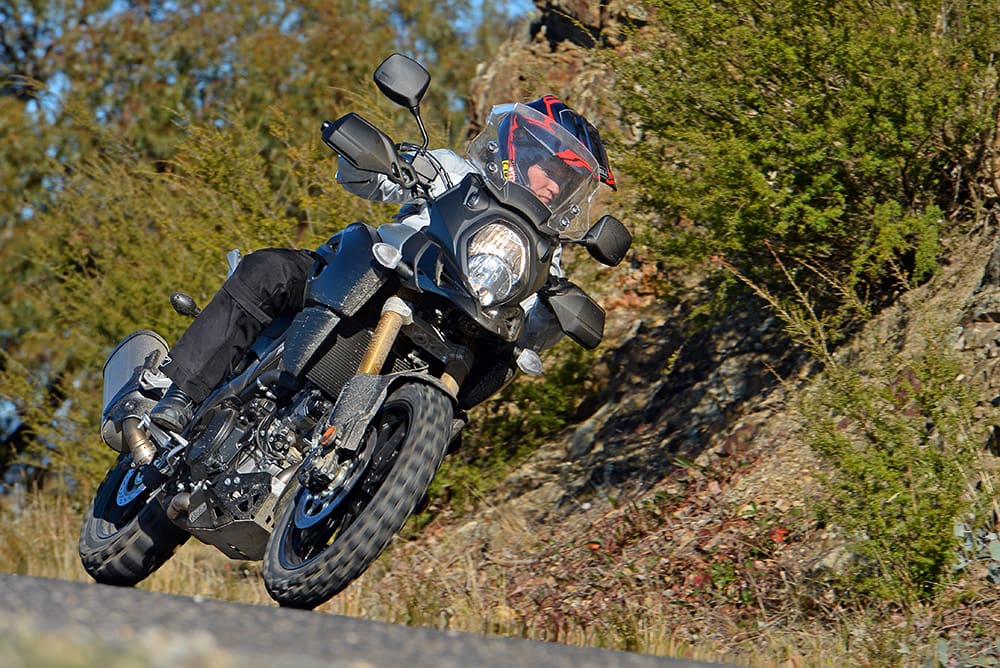
Honda CB500X
built in the classic soft-roader formula, the CB500X shares a broad model platform with the supersport 500R and the naked 500F. Apart from Dakar styling, the CB500X has no real connection with the off-road world; 17-inch cast wheels and short travel suspension (120mm /140mm) place its focus squarely on the bitumen.
But, like all good soft-roaders, the Honda’s wide bars and neutral upright riding position allow it to tackle gravel roads with ease. It has low weight and small proportions on its side, and light steering, a soft broad spread of power, and ABS braking, all help make it great for building confidence on loose surfaces.
Limited options in off-road biased tyres, and the suspension travel are the main hurdles to Adventurising the 500X. But with its simplicity and reliability, it lends itself to creating a DIY lightweight adventure tourer.

The little Honda is a neat and attractive machine, and everyone who rode it came away with a glow of pleasant surprise at how much fun such a fundamentally basic bike can be. Being LAMS-approved it would be a good choice for learners with a desire to get out of town on weekends or get into touring early in their riding life.
At $7490 the CB500X is one of the less expensive entries into the world of adventure touring, as well as a versatile and practical city runabout. And you only need to look at the Honda genuine accessory catalogue to find the parts to turn the CB500X from plucky little commuter bike into capable cross-country tourer: luggage racks and panniers, hand guards, LED riding lights, heated grips, taller screen, and even a wiring harness to fit auxiliary power supply and navigation systems.
The CB500X may not be a thoroughbred adventure bike, but it shouldn’t be underestimated. Like any good adventure, it is what you make it.
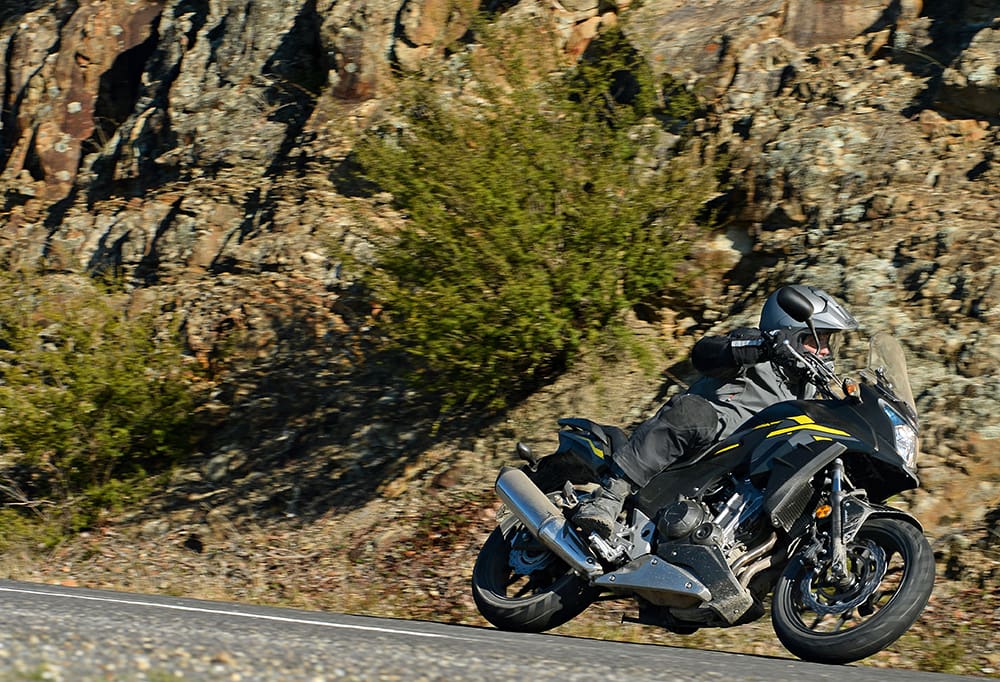
Dual Sport
Best of both worlds
dual-sport is a name that goes back a long way, and used to describe any bike which fell between a road bike and a competition off-road motorcycle. Nowadays, of course, that covers the entire spectrum of adventure bikes. The KLR650s and DR650s which once would have been the essence of dual-sport – and are still referred to as such – are now the most versatile bikes in the spectrum and defy this simple definition.

For this feature we have reinterpreted the dual-sport name and applied it those soft-road models that have been gifted with the bare essentials to cross the tarmac/dirt divide. This could include a set of tougher spoked wheels with a 19-inch front for easier rolling over rough terrain, dual-sport tyres as standard, or slightly extended suspension travel.
A 19-inch front wheel is the minimum size required to gain access to the full and extensive range of true adventure tyres available, and this is one of the most important considerations when selecting a bike to take onto any loose dirt or gravel. Larger wheels are also less prone to being swallowed by pot holes.
Aprilia Caponord 1200 Rally
At first glance you may think the Caponord Rally would belong in our adventure-touring category, and you’d be right to imagine that it would make a great bike for that purpose. Its 1200cc V-twin engine is one of the sweetest hearts ever to beat a rhythm on the road, and when I attended the model’s Oz launch it made me want to chuck in the day job and start riding a lap of the country then and there. The Rally is also super stable and a load of fun on well-graded gravel.
Upgrades from the soft-road model Caponord Strada are many, and help push the Rally model further into the adventure end of the market. These include tougher tubeless spoked wheels with 19-inch front, sump guard, hand guards, and crash bars. The Rally also offers one of the most complete touring packages on the market, with aluminium panniers, LED riding lights, and cruise control all standard features.
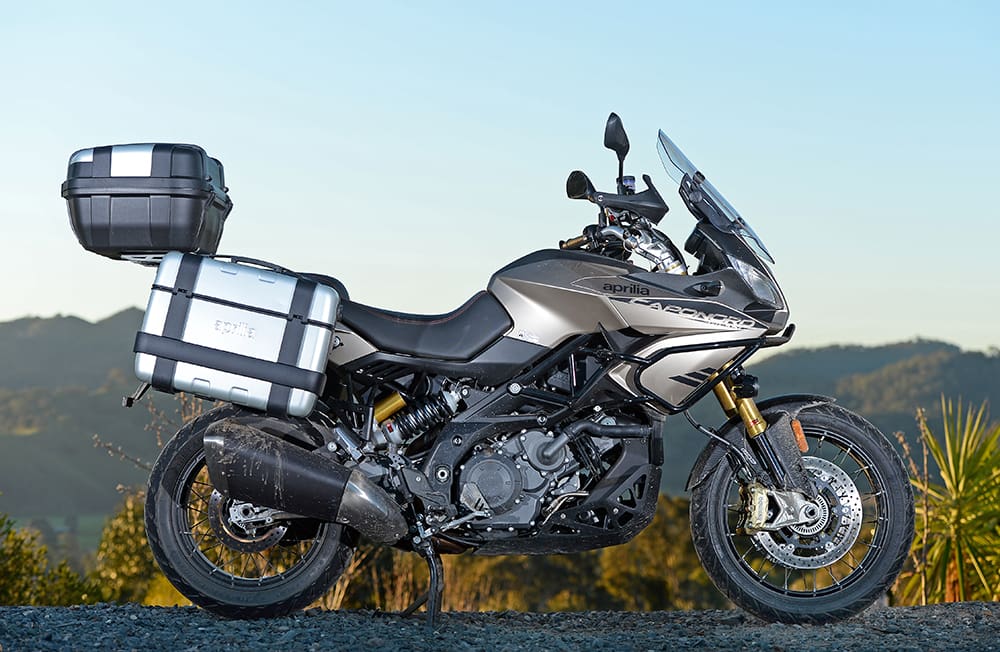
What differentiates the Aprilia from the bikes on the next page is something you will recognise as a recurring marker throughout the spectrum of adventure: suspension travel. Although the Rally is undoubtedly a robust back-country tourer with suspension tuned to handle some off-road excursions, it still has the same maximum suspension movement as the road-oriented Caponord models of 167mm at the front and 150mm at the rear. Aprilia’s ADD semi-active electronically controlled rear shock does a remarkable job of making the most of the available travel, but when the going gets really tough there’s no substitute for inches.
Still, the Caponord Rally will suit the adventure touring needs of 95 percent of riders perfectly. It’s tough enough to tackle the majority of routes, comes with most of the must-have accessories fitted, and has a personality that will make you want to get lost in the horizon.
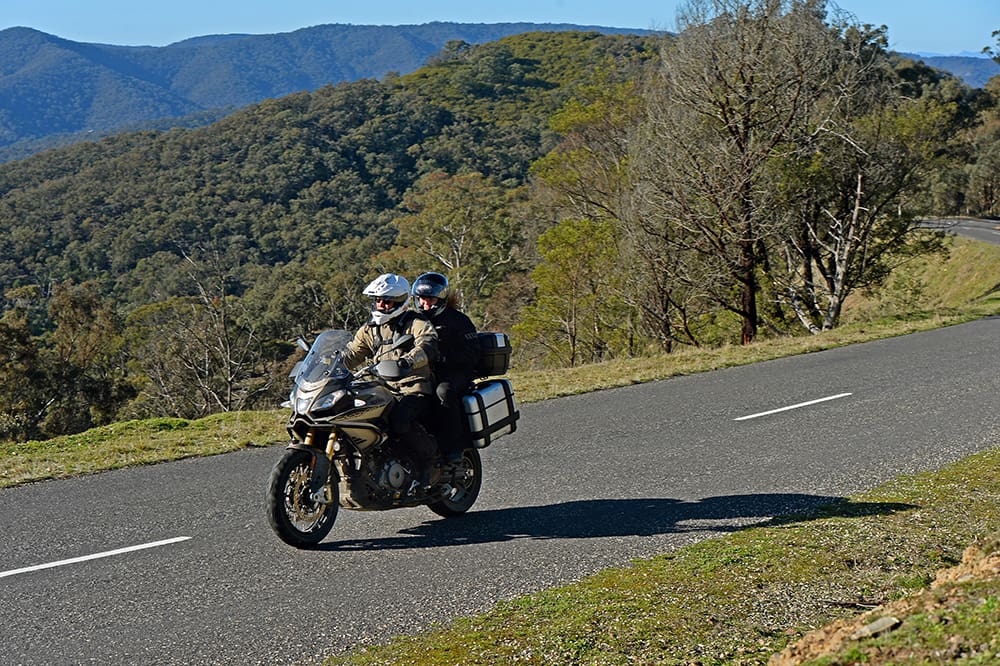
Suzuki V-strom 650XT LAMS
For 2015 Suzuki gave its popular V-Strom 650 soft-roader a light stroke with the off-road brush to create the 650XT. Tubeless wire spoked wheels give a more forgiving ride on rough roads, which in turn reduces the risk of rim damage and softens the blows transferred to the rider. Crash bars, hand guards, engine protection, and the Dakar beaked fairing complete the XT package.
Available in LAMS or non-LAMS flavour, the 650XT will fill many roles for many people, and gives them all the added opportunity to indulge in a little weekend dirty work if they so desire.
Like the V-Strom 1000, the 650XT has a low handlebar and short bar-to-footpeg distance, which makes standing up for rough terrain slightly awkward. The majority of the time though, the 650 ’Strom is one of the most relaxing and natural places to perch your posterior.
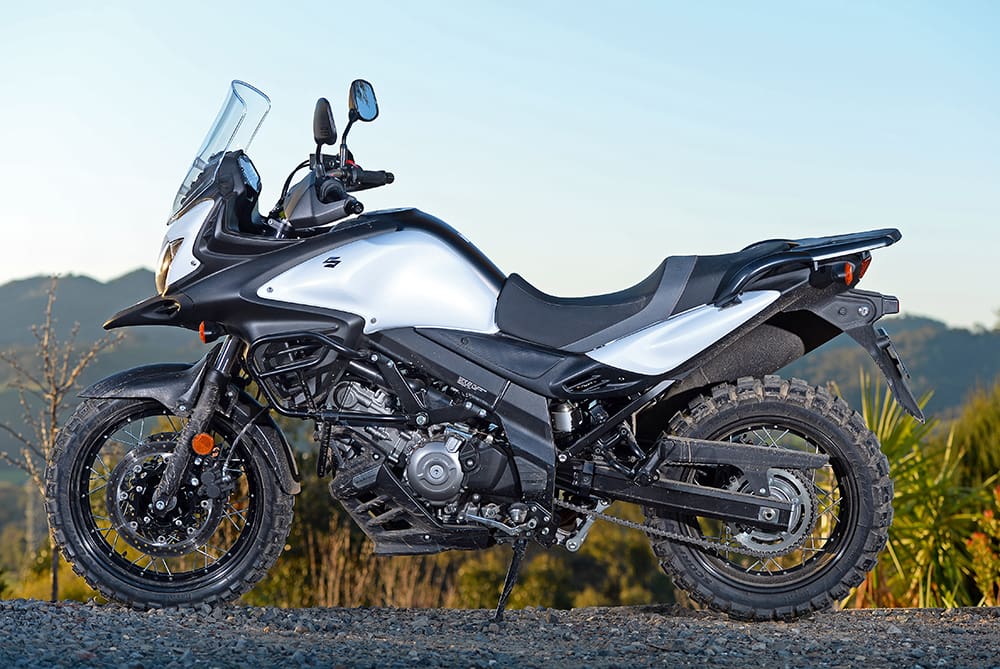
Chances are you won’t be spending too much time standing up on the pegs anyway, as this bike isn’t really a tool for serious off-roading. Yep, you guessed it, suspension travel. Preload adjustment at the front and rear allows you to stiffen up your settings for carrying luggage, and rebound damping adjustment on the rear will help keep everything under control, but the 150-159mm of travel front to rear will always limit the terrain you can tackle – and your speed across it.
A relatively lightweight bike like the 650XT does have an advantage over heavier dual-sport bikes: being able to run lower tyre pressures without risking wheel damage. This also depends on the tyre size and construction, but the cushioning effect of lower pressures can add centimetres to your suspension.
The 650XT is a deservedly popular bike which happily mixes city life with dirty weekends away, and has a reputation of long faithful service.

Adventure Touring
Lapping in luxury
Adventure Touring is a role any of the bikes in these pages could perform to a point, but these days there are bikes designed with extra features specifically for the purpose. Cruise control, long-range tanks, heated grips, comfort seats, tall screens, and above all luggage capacity, are just some of the added extras or options expected of a modern adventure tourer.
The most capable bikes in this sector will have uprated and extended suspension compared to their soft-road or dual-sport variant, and spoked wheels with 19- or 21-inch front designed to cope with high loads on rough terrain. Other features such as serrated off-road foot pegs and aluminium sump guards signify true dirt focus.
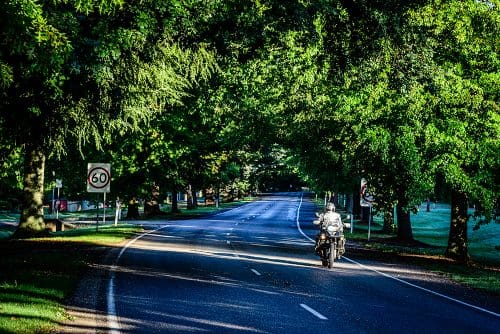
The main downside to these kinds of bikes is that they can be tall and heavy, and subsequently challenging to handle off-road for inexperienced, weaker, and smaller riders. But if it’s thousands of kilometres of dusty roads you seek to conquer in comfort, you’ll find a little bit of luxury goes a long way. And if you’ve got the determination, these bikes will take you all the way.
BMW R 1200 GS Adventure
What can be said about this iconic bike which has not already been said? The GS virtually owns the name adventure touring, and its phenomenal sales figures prove that motorcyclists all over the world identify the GS as a market leader in the sector.
I’ve always been of the opinion that if BMW were to design an adventure touring bike from scratch today, a opposed-twin engine layout would be the last thing they’d use. When it comes to dirtbike engine design, narrow is best. But the legend of the boxer-twin and its links to the Dakar Rally, and intercontinental touring in general over the last century, is so irrepressible that the GS has a life force beyond pure practicality. And BMW loves its Boxer heritage so much that it puts the effort in to make it work.
The top-of-the-range GS Adventure is a very serious bike built for serious adventure. At 260kg fully fuelled with no luggage, it needs a serious rider, all of its 125Nm of grunt, and all of its 220mm of suspension travel to bulldoze a path to the back of beyond. But if you’ve got the skills, strength and determination, get you there it will.
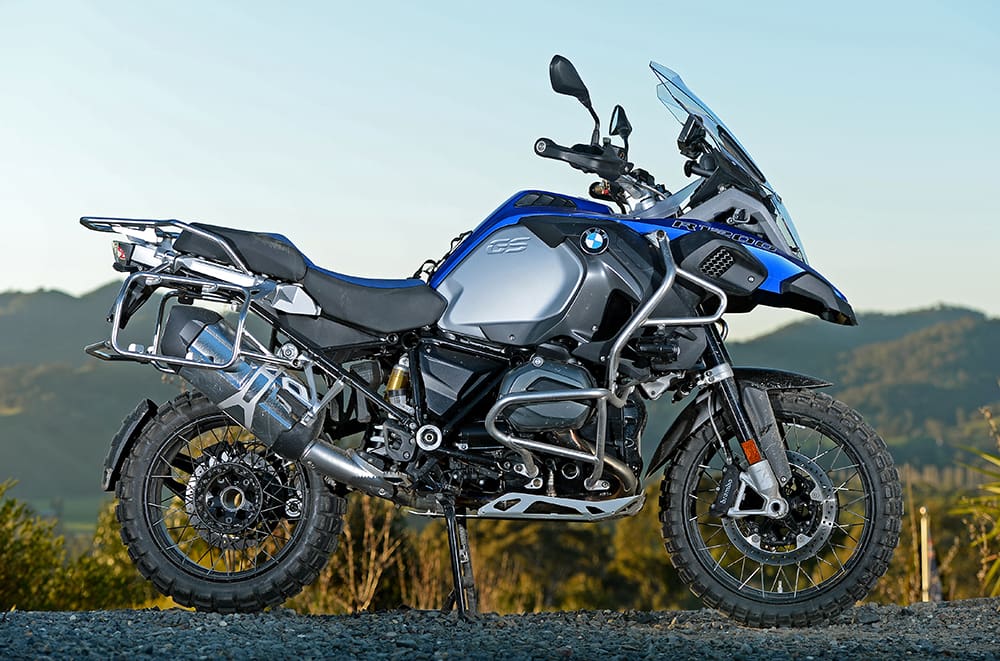
Not only will it get you there, it will do so in a level of comfort which is the benchmark for all types of touring motorcycles worldwide. Every detail of a rider’s and pillion’s needs is researched and attended to as part of the never-ending development of the GS species. Even if you are not a GS fan, this is something which has to be admired. BMW are masters of the one-with-the-lot level of appointment, to the point of producing bikes which are the epitome of fully-loaded. So if you are a one-with-the-lot kind of rider with a soft spot for tradition and a love of luxury, well, you probably already own a GS.

Triumph Tiger 800 XCx
When the Tiger 800 XC was first launched, with a new engine inspired by the successful Daytona 675 supersport bike, no one expected Triumph to become such a big player in the adventure market, including Triumph. But the model has evolved into the most exciting middleweight adventure tourer around.
New for 2015, the XCx is the most serious off-roader of Triumph’s modern era. Working with dirt and adventure bike suspension specialists WP has lifted the model to new levels of off-road performance, and the once slightly underwhelming 800cc engine has been transformed into one with the guts and character worthy of its Daytona heritage.
Fly-by-wire throttle has added tricks like traction control, cruise control, and riding modes, and it also helps delivers far better fuel economy than the previous model.
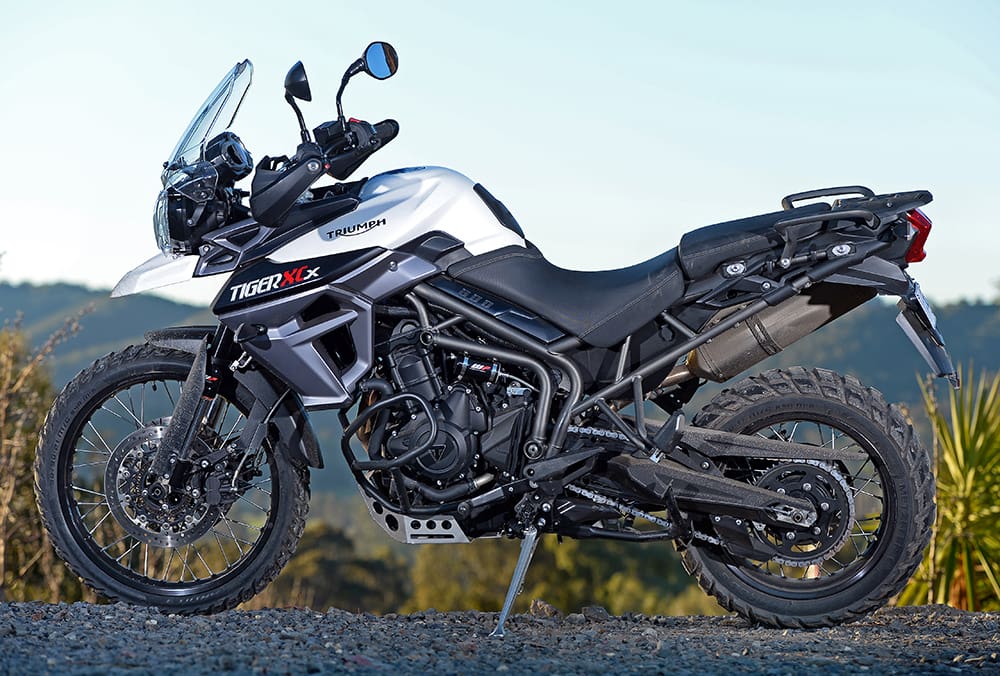
Triumph provides all the possible accessories an owner could desire, and often partners with established high quality accessories manufacturers to supply the Triumph-branded equipment. A fully-loaded Tiger is one of the most comprehensively equipped and capable adventure tourers on the market of any engine capacity.
Being light when compared to the big-bore options, and the only three-cylinder middle-weight in the high-end adventure touring category, gives the Tiger 800 XCx a unique balance of attributes. And riding it makes you seriously wonder whether heavier and larger-capacity bikes are really necessary.
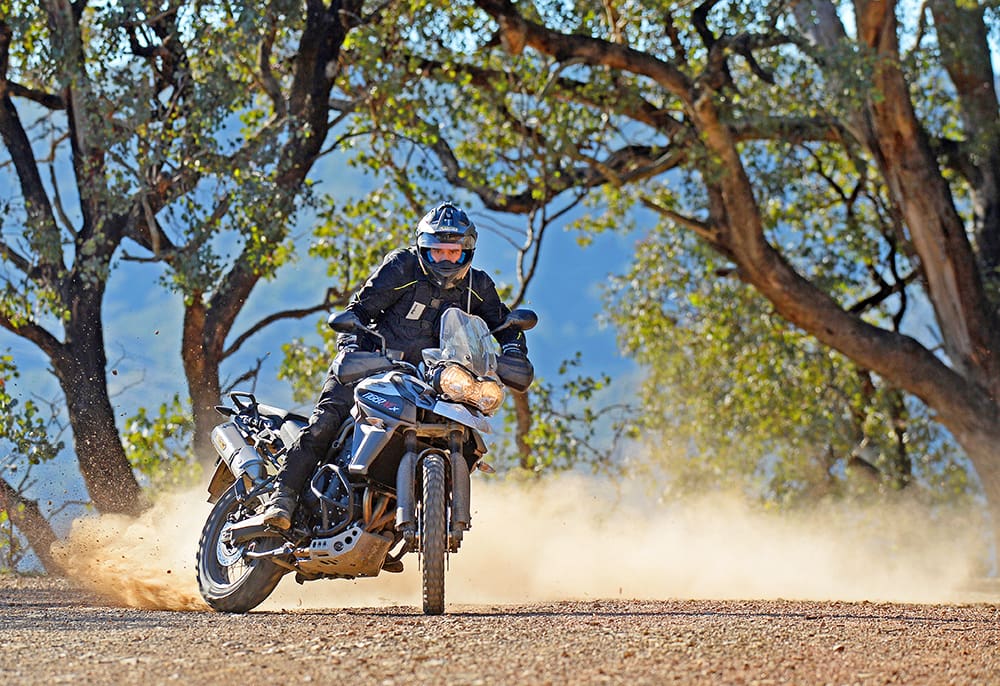
Adventure Sport
Playing rough
Adventure Sport represents the final evolution of the transformation into a fully formed and focused off-roader. These are big-bore street-legal dirt bikes, and the closest cousins to the fearsome Dakar Rally machines which ripped across the Sahara Desert prior to the adoption of the 450cc limit for Rally racing, and the Paris-Dakar Rally’s migration to South America.
Off-road tuned suspension with travel of 200mm or more, tough spoked wheels with 21-inch diameter front, and attention given to achieving maximum ground clearance and minimum weight are all signs of effectiveness when the going gets extra rough. Crossing continents using the shortest possible route and at the highest average speed is what these bikes are all about.
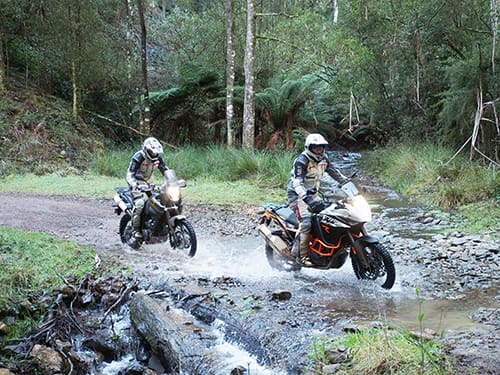
There are fewer ready-made options in this sector of the spectrum, but depending on your own strength and skills, the bikes in the sectors on either side could also be considered applicable to the adventure sport tag. But above all, the bike must be designed primarily to handle on the dirt, and robust enough to take a serious beating.
Yamaha Ténéré XTZ660
A Go-anywhere design philosophy is what Yamaha claims has inspired the most recent incarnation of its legendary Ténéré adventure bike, and the proposition is certainly true. But the ancient and simple single-cylinder trailbike recipe of light
weight, long legs, and a bulletproof build, is one which has always made perfect sense for the rigours of adventure riding.
Although it would be entirely possible to push its power output to far higher levels, a focus on under-stressing the XTZ660 to maximise durability has meant the bike remains a simple SOHC design and is also LAMS-approved. As such, the Ténéré represents the most hard-edged production adventure bike available for learners. Its soft power delivery suits newcomers to the dirt, but shorter and less experienced riders may initially find its tall off-road ready chassis and suspension a challenge.

When the going gets really rough the Ténéré feels like it’s in its natural environment, eating up rock strewn tracks with ease and control. Low stressed single-cylinder economy means its 23-litre tank will get you much further than you will want to travel in one hit, but even bigger tanks and a plethora of adventure gear are available for this original member of the early Adventure bike revolution.
Being around so long, the Tén has amassed a legion of fans and fanatics, all with stories to tell and experience to offer to new converts. Yamaha’s annual adventure ride and gathering for these folk is lightheartedly known as Ténéré Tragics.
These tragics will all tell you one thing if given a chance: “If you’ve got the guts, the legs, and the will, so has the Ténéré.”

KTM 1190 Adventure R
Conceived and built for just one job from the very beginning, the 1190 R carries the torch for all KTM’s Dakar racers which have come before it. Still displaying the delightfully uncompromising character which typifies the spirit of KTM, this battleship of the desert will inject excitement into your adventure like no other bike. But you do need to be sure about just how much excitement you can take.
Its towering seat height and whopping wheel base project an imposing silhouette. For those willing to take it on, the rewards are big and the adventures are boundless.
KTM has been making championship winning off-road bikes for MX, enduro, and desert racing for decades, and all that expertise has been channelled into this flagship of its off-road range. It’s no wonder it has the feel of an MX bike on steroids. For anyone with a dirt background it is the ultimate adventure tool: a familiar dirtbike feel with more power than you could wish for.
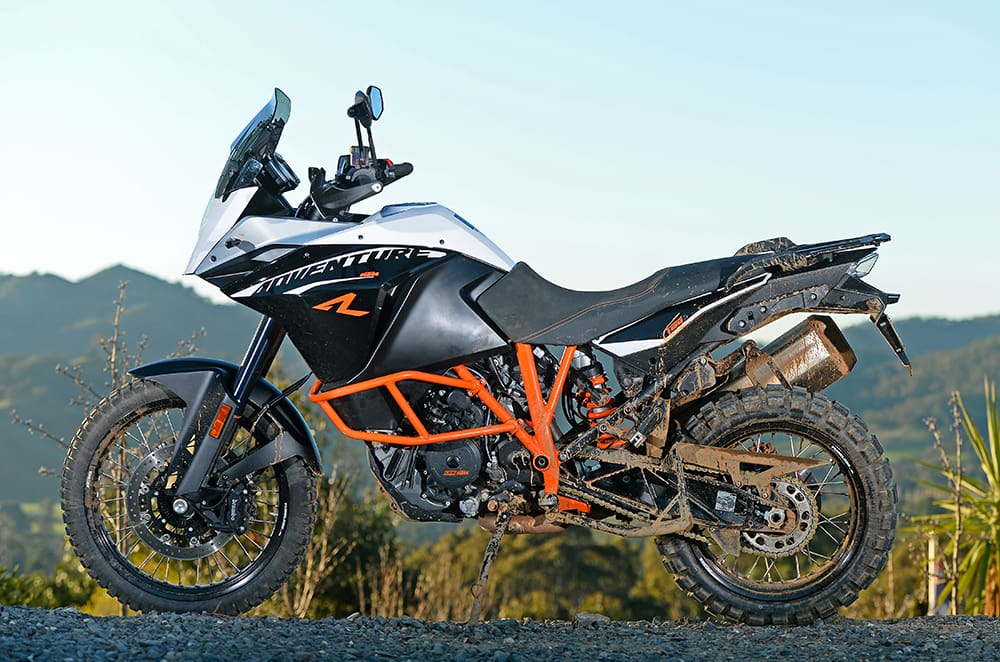
For those not wanting the full 110kW, rider modes allow a power reduction. Traction control and ABS can also be trimmed to fit your sense of fun or fear.
Now the KTM line-up includes the softer-road 1050 and the über-luxury 1290 models, it’s good to see the 1190 R continuing the hard edge of the range. The fact that KTM expects it to remain the bestseller in the range, and now fits off-road tyres to the 1190 R purely for the Aussie market, shows we are among the most serious Adventure bike riders in the world.

Taking it to the limit
Extreme Adventure riders who are both talented and strong enough could take any of the bikes in these pages to places you would imagine only a mountain goat could access. For the rest of us, the bike we ride will determine the depth of our adventure. To ride on terrain you would only attempt on a motocross bike, a street-legal enduro bike is the ideal option. These can be converted into ultra-lightweight, long-range, super-tough Adventure bikes with ample cargo capacity.

The trail bikes once called dual-sport can also fit into this role with a careful mix of accessories. Generally four-stroke singles from 250 to 650cc, some air-cooled and steel framed options are still available for the ultimate in low-tech simplicity and ease of repair in remote locations.
ADR’d 250 to 450cc competition enduro bikes, like the ones which are converted into the current Dakar Rally racers, are at the most extreme end of the adventure spectrum. They may not be the most comfortable way to cruise the black-top, but when the going gets rough there’s none better suited to the job.
Yamaha WR250R
This unassuming 250cc trail bike was the surprise packet of the bunch on our trip to the Victorian high country, and despite not being a no-holds-barred off-road competition model, the WR250R more than deserves its slot in the extreme adventure sector.
Like the WR450F across the page, the WR250R was delivered to us complete with the typical accessory wish list you would dream up for a DIY adventure bike. This particular example was developed by NSW-based adventure ride organisers RideADV, in conjunction with Teknik suspension, and accessory retailer Adventure Moto. It is also the bike of choice for the team at Ride-ADV when researching the routes they offer as multi-day supported trail rides, and this spec of bike has already proven itself over thousands of kilometres of outback riding in their hands.
The beauty of choosing such a small bike for extreme adventure riding is it so much easier to get out of trouble when the limits have been pushed too far. An ultra-lightweight like the WR250R can be unpacked and dragged out of deep sand or mud where bigger and heavier bikes may have to be abandoned. Power-hungry riders will be unimpressed by the speed and acceleration of a 250cc engine, but if simply getting there is the priority of your adventure, the WR250R will deliver you to any destination with a smile on your dial.
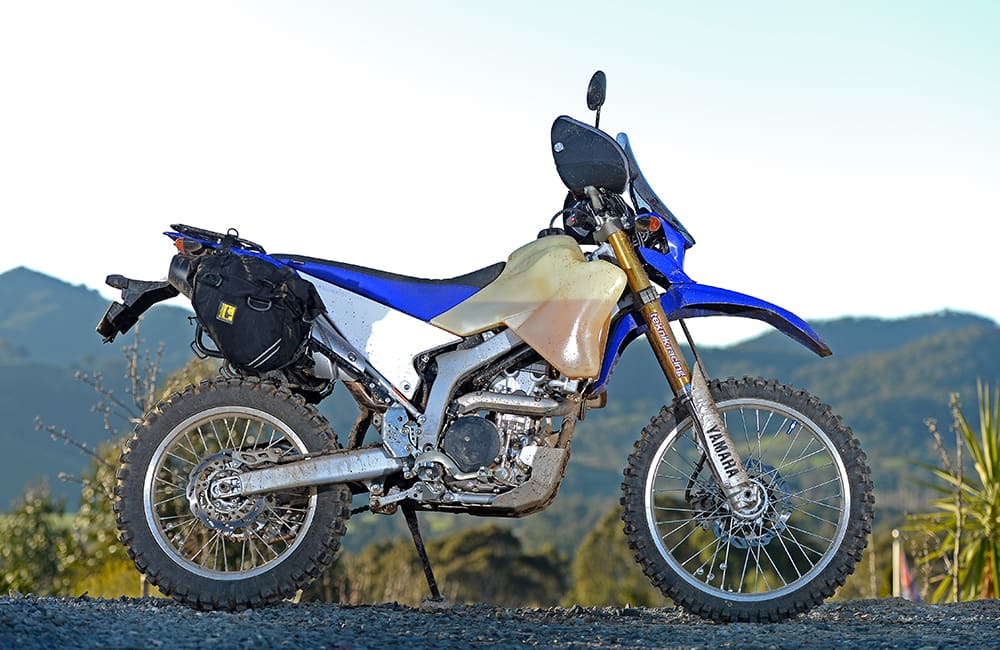
Fuel-injected, small-bore, water-cooled, and single-cylinder is a combination which adds up to enviable fuel economy. Throughout the three days of riding, the fuel level in the voluminous 17 litre IMS tank hardly seemed to drop, and a range approaching 450km wouldn’t be out of the question in favourable conditions.
LAMS-approved and hard-core proven, the WR250R will suit adventure apprentices and old warriors alike.
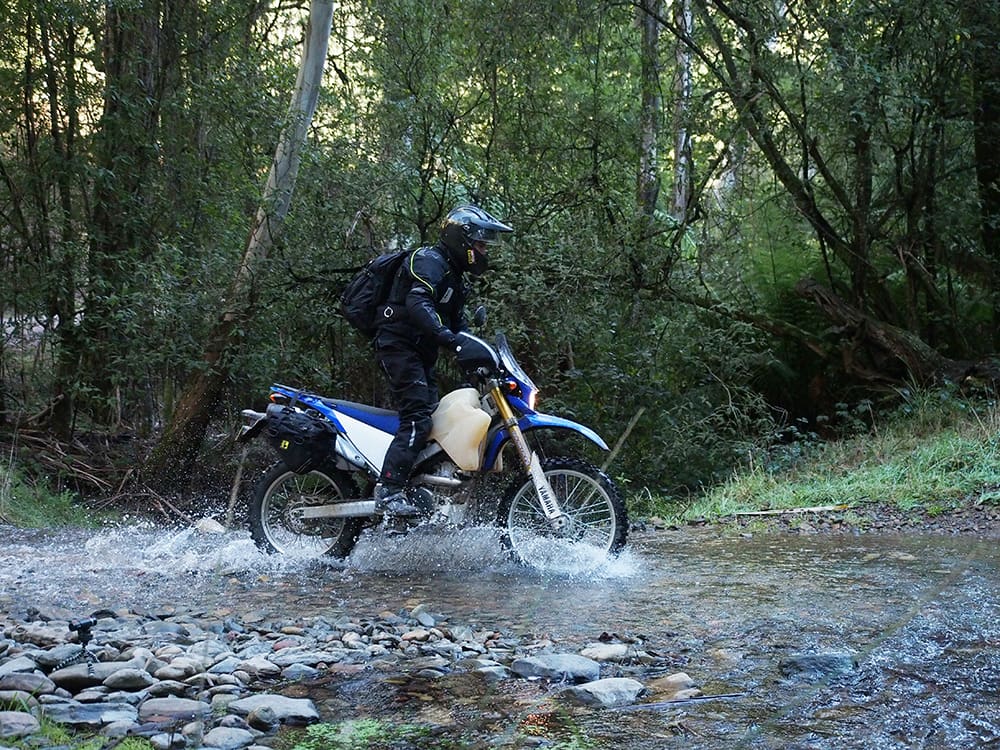
Yamaha WR450F
Go out into the bush anywhere in Australia and chances are a WR450 will be lurking nearby. Yamaha’s bestselling 450 is a fine balance of enduro racer and trusty bush basher, and this character has forged it a reputation as the go-to street-legal 450 for recreational trail riding.
The fact that much of its development was carried out on the rugged trails of the Australian bush means the WR450 was literally made for Aussie adventures. If there’s a mountain worth climbing or a river worth crossing, the power and the litheness of the WR450 will allow you to conquer it, and this makes the WR450 a perfect candidate for an Adventure bike conversion.
Because it uses a motocross-bred chassis designed to cope with the extreme abuse of monstrous jumps, the WR450 has no trouble bearing the added weight of extra fuel and racks full of luggage. The 15-litre tank on our test bike is made by Australian company Safari Tanks. In fact, many of the parts needed to build your own safari-ready bike are available as homegrown products. Hand guards like the Barkbusters on the WR are a must for saving levers and hands in a fall, and also keep wind chill off your digits on cold desert mornings.

Modern competition dirtbikes are becoming more civilised beasts with every passing year. Manufacturers know that if a bike is easier to ride, more riders will be able to get the most out of it, enjoy it, and will buy it. Fuel injection and electric starters have refined the breed even further, and nowadays a competition bike can be just as at home on the trail as it is on the start line.
This isn’t the best route of adventure to choose if you need the same bike for your daily city commute, but if its hard-core off-road thrills you’re looking for, the WR450 will deliver.
